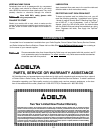
17
CUTTING A SHOULDER
Use the parting tool first to reduce the wood to within
1/16” of the required shoulder and diameter (Fig. 43).
Clean the waste stock out with the gouge (Fig. 44), then
use the skew for the actual cutting of the shoulder (Figs.
45A and 45B), which is a duplication of squaring an end.
The skew then makes the horizontal cut, but in a differ-
ent manner from plain cylinder work. If the shoulder is
long, use the ordinary skew position for the outer portion
of the cut. At the angle between the horizontal and ver-
tical cuts, the heel of the chisel moves into a position
tangent between the skew and the cylinder (Fig. 46). In
this position, raise the handle of the chisel slightly to
allow it to cut while the tool moves along the rest. Use a
very light cut to produce smooth work. The heel of the
skew can be used for making the entire cut, if desired,
but the cut, whether in this position or any other posi-
tion, should not be picked up directly at the end of the
stock. Horizontal cuts started directly from the end of
the work will have a tendency to bite into the wood,
often ruining the entire piece. Always run off the end and
not into it. Where a very short shoulder makes this
impossible, use the skew in a flat scraping position. If
the cutting technique is used, engage only with the heel
of skew in a very light cut.
CUTTING SMALL BEADS
Beads can be scraped or cut. Using the spear chisel is
the easiest method of scraping, and works to best
advantage on beads separated by parting tool cuts
(Fig. 46). Scraping is slower than cutting and is not as
clean, but it has the advantage of protecting the work
from long gashes.
Cutting beads quickly and accurately with the small
skew is one of the most difficult lathe operations.
Various working methods can be used . The first cut is a
vertical incision at the point where the two curved sur-
faces will eventually come together. Make this cut with
either heel or toe of skew. Fig. 47 shows the use of the
toe. Place the skew at right angles to the work . The chis-
el is flat on its side at the start, and is evenly rotated
through the successive stages of the cut (Figs. 48, 49
and 50). At the same time, the chisel is pulled slightly
backward to maintain the cutting point. The entire cut is
made with the heel of chisel. The opposite side of the
bead is cut in the same manner, one cut serving to
produce the full shape in each instance. This action
produces beads that are beautifully smooth and
polished, and the technique is well worth mastering.
Fig. 43
Fig. 44
Fig. 45
Fig. 46
Fig. 46
Fig. 47
Fig. 48
Fig. 49
Fig. 50


















